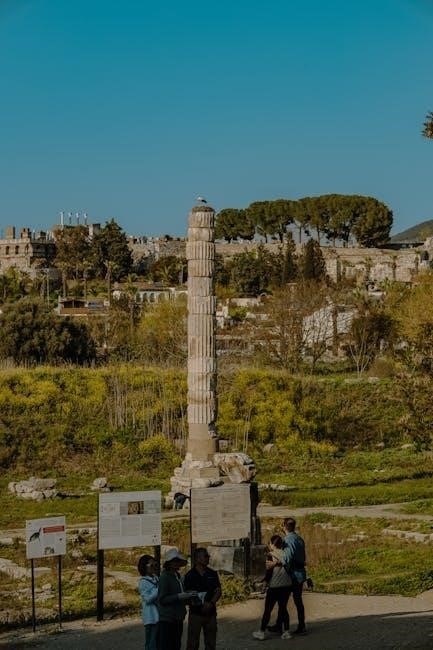ap world history multiple-choice questions pdf
Overview of the AP World History Exam
The AP World History Exam is designed to test students’ knowledge of world history from the year 600 to the present.
The exam is divided into several sections, including multiple-choice questions, short-answer questions, and essay questions.
Section I of the exam contains 70 multiple-choice questions, which are designed to test students’ ability to analyze and interpret historical information.
The multiple-choice questions are based on a range of historical topics, including social, political, and economic developments.
The exam also includes short-answer questions, which require students to provide brief answers to historical questions.
The AP World History Exam is scored on a scale of 1 to 5, with 5 being the highest score.
Students who score a 3 or higher on the exam are considered to have passed and may be eligible for college credit.
The exam is typically taken by high school students who have completed an AP World History course.
Importance of Multiple-Choice Questions in the Exam
Multiple-choice questions play a significant role in the AP World History Exam, as they test students’ ability to analyze and interpret historical information.
These questions require students to think critically and make connections between different historical events and concepts.
The multiple-choice questions also help to assess students’ knowledge of historical themes, such as social, political, and economic developments.
By including multiple-choice questions, the exam provides a comprehensive assessment of students’ understanding of world history.
The questions are designed to be challenging, yet accessible, and require students to apply their knowledge of historical concepts to specific scenarios.
Overall, the multiple-choice questions are an essential component of the AP World History Exam, as they provide a fair and accurate assessment of students’ knowledge and skills.
The use of multiple-choice questions also allows for efficient and accurate scoring, making it easier to evaluate student performance.

Sample Exam Questions and Learning Objectives
Sample exam questions and learning objectives are provided online for student review purposes only with pdf files available.
Relationship between Curriculum Framework and the Redesigned AP World History Exam
The relationship between the curriculum framework and the redesigned AP World History Exam is crucial for understanding the exam’s structure and content. The curriculum framework provides a clear outline of the course’s learning objectives and key concepts. The redesigned exam is designed to assess students’ knowledge and skills in a more comprehensive and nuanced way. The exam questions are aligned with the curriculum framework, ensuring that students are tested on the most important concepts and skills. The relationship between the curriculum framework and the exam is evident in the way the exam questions are organized and structured. The exam is divided into several sections, each assessing a specific set of skills and knowledge. The curriculum framework provides a roadmap for teachers and students to follow, ensuring that they are well-prepared for the exam. By understanding the relationship between the curriculum framework and the exam, students can better prepare themselves for the challenges of the AP World History Exam. The curriculum framework and exam are closely tied, and understanding this relationship is essential for success.
Examples of Multiple-Choice and Short-Answer Questions
Examples of multiple-choice and short-answer questions can be found in the official study materials and online resources. These questions demonstrate the types of questions that will be asked on the exam and provide students with an opportunity to practice their knowledge and skills. Multiple-choice questions will test students’ ability to recall and analyze historical information, while short-answer questions will require students to provide more in-depth and nuanced responses. The questions will cover a range of topics and time periods, from ancient civilizations to modern global issues. By reviewing examples of multiple-choice and short-answer questions, students can gain a better understanding of the exam’s format and content. This will help them to prepare effectively and build their confidence in tackling the types of questions they will encounter on the exam. The examples of questions will also help students to identify areas where they need to focus their studies.

Exam Overview and Practice Exam
Exam overview includes practice exam and scoring information details
Section I, Part A: Multiple-Choice Questions Instructions
Section I of the exam contains 70 multiple-choice questions and students are required to mark all of their answers on the answer sheet included in the booklet. The multiple-choice questions are designed to test students’ knowledge of world history and their ability to analyze and interpret historical information. The questions are based on the curriculum framework and are designed to assess students’ understanding of historical concepts and themes. Students are advised to read each question carefully and choose the correct answer from the options provided. The multiple-choice questions are scored based on the number of correct answers, and students are not penalized for incorrect answers. The instructions for the multiple-choice questions are provided at the beginning of the exam, and students are expected to follow them carefully to ensure that their answers are marked correctly. The multiple-choice questions are an important part of the exam, and students should allocate their time wisely to answer all 70 questions.
Section I, Part B: Short-Answer Questions and Historical Thinking
The short-answer questions in Section I, Part B of the exam are designed to test students’ historical thinking skills and their ability to analyze and interpret historical information. The questions are based on the curriculum framework and are designed to assess students’ understanding of historical concepts and themes. Students are required to provide concise and well-supported answers to the questions, using evidence from the provided sources. The short-answer questions are scored based on the quality of the answers, and students are expected to demonstrate their historical thinking skills, such as contextualization, comparison, and causation. The questions are designed to be answered in a limited amount of time, and students should allocate their time wisely to answer all the questions. The short-answer questions are an important part of the exam, and students should be well-prepared to answer them correctly. Historical thinking skills are essential to answer these questions correctly.

AP World History Multiple Choice Questions and Answer Key provides scoring information online
The Question Alignment to Course Framework and Scoring Information is crucial for understanding the AP World History Exam.
The alignment of questions to the course framework ensures that the exam accurately reflects the course content and learning objectives.
The scoring information provides details on how the questions are scored and what percentage of the total score each question contributes.
This information is essential for students and teachers to understand the exam format and content.
The course framework is divided into several periods, each with its own set of learning objectives and key concepts.
The questions on the exam are aligned to these learning objectives and key concepts, ensuring that the exam is a fair and accurate assessment of student knowledge.
The scoring information is available online, providing students and teachers with detailed information on how the exam is scored.
This information can be used to prepare for the exam and to understand the results.
The AP World History Exam is a comprehensive assessment of student knowledge, and the question alignment and scoring information are essential components of the exam.
Publicly Available Exams and Test Preparation Resources are essential for students preparing for the AP World History Exam.
The College Board provides a range of resources, including publicly available exams and practice questions, to help students prepare.
These resources can be accessed online and include complete exams, as well as individual questions and answers.
Additionally, there are many online resources and study guides available to help students prepare for the exam.
These resources include practice tests, flashcards, and study guides, and can be a valuable tool for students looking to improve their knowledge and understanding of the course material.
The publicly available exams and test preparation resources are designed to help students assess their knowledge and identify areas where they need to focus their studying.
By using these resources, students can gain a better understanding of the exam format and content, and can develop a study plan that is tailored to their needs.
The resources are available to all students, and can be a valuable tool in preparing for the AP World History Exam.

and Online AP World History Practice Exams
These exams provide students with the opportunity to practice their knowledge and skills in a timed and simulated environment.
The online exams are available in a variety of formats, including multiple-choice questions and free-response questions.
Students can use these exams to identify areas where they need to focus their studying and to develop a study plan.
The online exams are also a great way for students to get a sense of the exam format and content.
Many online resources offer complete practice exams, as well as individual questions and answers.
These resources can be accessed from anywhere with an internet connection, making it easy for students to study and prepare for the exam.
By using online AP World History practice exams, students can feel more confident and prepared for the actual exam.
Overall, online practice exams are a useful tool for students preparing for the AP World History Exam.